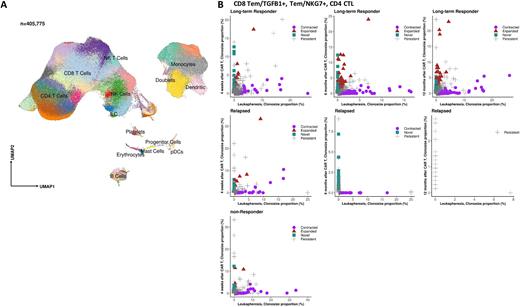Abstract
Background: Axicabtagene ciloleucel (Axi-cel), a CD19 directed CAR T cell therapy, results in durable remission in a subset of patients with relapsed refractory large B cell lymphoma (LBCL) in the absence of persistent circulating CAR T cells.
Aim: We postulated that long-term efficacy of CAR T therapy depends on the downstream triggering of native T cell immunity. To investigate this hypothesis, we performed single cell transcriptomic analysis of peripheral blood samples obtained at serial time points from patients participating in the ZUMA 1 Axi-cel study. We interrogated the T cell repertoire in patients who achieved durable remission compared to those experiencing disease relapse with respect to the expression of activated, cytotoxic, and inhibitory markers and clonotypic expansion of critical T cell subsets.
Methods: Single cell immunoprofiling (expression + V(D)J sequencing) was performed using the 10x Genomics single cell 5' assay on PBMC samples from ZUMA-1 patients (N=32), collected at leukapheresis, 4 weeks, 6 months, and 12 months post Axi-cel. Based on clinical response, patients were divided into 3 groups: non-responders (N=8), relapsed within 1 year from CAR T infusion (N=9), and long-term responders (N=12). Three participants did not consent to the release of clinical outcomes.
Results: A total of 405,775 cells passed quality check, capturing 73 cellular populations (Fig. 1a). T cells comprised the largest compartment with 28 different populations and 264,059 cells.
Long-term responders demonstrated a distinct T cell landscape compared to relapsed patients, notable for a higher CD8/CD4 T cell ratio and increased expression of cytotoxic genes at all time points. Accordingly, activated CD8 cytotoxic effector memory T cell (Tem) populations were significantly increased in long-term responders compared to relapsed patients; especially two Tem populations, one characterized by high expression of CD44, GZMB and TGFB1 (Tem/TGFB1+), and a second highly expressing cytotoxic markers such as GZMA, GZMB, NKG7, CTS7, and CTSW (Tem/NKG7+). Following CAR T cell infusion, relapsed patients exhibited increased proportions of T regs and of T reg-like Th17 cells highly expressing FOXP3, IL2RA, and CTLA4. In contrast to all other CD4 populations, which were more abundant in the relapsed group, long-term responders presented higher abundance of CD4 cytotoxic T lymphocytes (CD4 CTL), characterized by high expression of both CD4-related and cytotoxic markers, including granzymes, and GNLY.
Comparison of the TCR repertoire pre- and post-CAR T demonstrated a greater clonal expansion (TCRα/β-clonotype frequency > 1) of cytotoxic T cell populations in the long-term responders compared to relapsed and non-responder patients. In particular, higher clonotypic expansion was observed in the Tem/TGFB1+, Tem/NKG7+, and CD4 CTL populations (Fig. 1b). In contrast to our observations for the cytotoxic T cell populations, T regs were identified as more clonally expanded over time in the relapsed patients compared to the long-term responders.
Conclusion: The application of single-cell immunoprofiling on longitudinal samples from CAR T cell treated LBCL patients from the ZUMA-1 trial demonstrated striking differences in cellular populations and clonal expansion patterns among patients who demonstrated long term remission compared to those who relapsed within 1 year following initial response. Reduced cytotoxic T cell expansion and increased proportions of immunomodulatory T cell populations were noted in relapsed patients compared to long term responders. These data provide insight into crucial factors that can be leveraged both to predict patient response and to further our understanding of long-term remission following CAR T cell treatment.
Disclosures
Stroopinsky:Takeda: Current Employment. Miles:Kite: Current Employment. Tiwari:Kite: Current Employment. Kim:Gilead Sciences: Other: current holder of RSU in a public company; Kite, a Gilead Company: Current Employment. Mattie:Kite/Gilead: Current Employment. Rosenblatt:Wolters Kluwer Health Inc: Other: Spouse COI; Karyopharm Therapeutics: Other: DSMB; Dava Oncology: Other: Education; Celgene: Membership on an entity's Board of Directors or advisory committees; Partner Tx: Membership on an entity's Board of Directors or advisory committees; Attivare Therapeutics: Consultancy; Bioclinica: Consultancy; Imaging Endpoint: Consultancy; Parexel: Consultancy; Kite: Membership on an entity's Board of Directors or advisory committees; BMS: Membership on an entity's Board of Directors or advisory committees; Merck: Membership on an entity's Board of Directors or advisory committees; Amgen: Membership on an entity's Board of Directors or advisory committees; Sanofi: Research Funding; BMS: Research Funding; Celgene: Research Funding; Kite: Honoraria. Avigan:Sanofi: Consultancy; Kowa: Consultancy; Kite: Consultancy; Takeda: Consultancy; Janssen: Consultancy; Parexel: Consultancy; Kite: Membership on an entity's Board of Directors or advisory committees; Chugai: Membership on an entity's Board of Directors or advisory committees; Legend Bio Tech: Membership on an entity's Board of Directors or advisory committees; Takeda: Membership on an entity's Board of Directors or advisory committees; Aviv MedTech Ltd.: Membership on an entity's Board of Directors or advisory committees; BMS: Membership on an entity's Board of Directors or advisory committees; Karyopharm: Membership on an entity's Board of Directors or advisory committees; Partners Tx: Membership on an entity's Board of Directors or advisory committees; Juno: Membership on an entity's Board of Directors or advisory committees; Celgene: Membership on an entity's Board of Directors or advisory committees; Kite: Research Funding; Pharmacyclics: Research Funding; Celgene: Research Funding. Vlachos:Singular Genomics: Research Funding; NextRNA: Consultancy; National Institute of Health: Research Funding; Mosaic: Consultancy; Guidepoint Global: Consultancy; Department of Defense: Research Funding; Botanisol Analytics: Research Funding; Takeda Pharmaceutical: Current Employment.
Author notes
Asterisk with author names denotes non-ASH members.


This feature is available to Subscribers Only
Sign In or Create an Account Close Modal